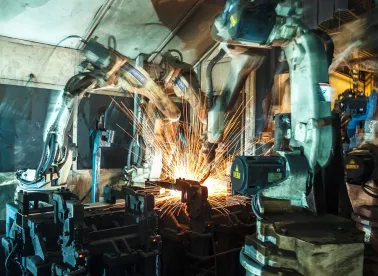The North American automotive supply industry convened in suburban Detroit on November 13th at The Original Equipment Suppliers Association (OESA) 21st Annual Conference under the theme: “Racing to Innovate.” And while the conference included lots of discussion on automation, electrification, other innovations and a thought-provoking keynote by bestselling author Jim Collins (“Good to Great”), the Industry Outlook was dominated by words like “Uncertainty,” “Risk” and “Headwinds” which are threatening to slow down this “Race” as we head into 2020.
Mike Jackson, Executive Director of Strategy and Research for the OESA, moderated the panel, which included Elaine Buckberg, Chief Economist, General Motors Company; Jeff Schuster, President, Americas Operation and Global Vehicle Forecasting, LMC Automotive; and Brian Johnson, Managing Director, Global Autos Research, U.S. Autos & Auto Parts, Barclays Bank. Each panelist gave a short presentation of their 2019-2020 world view for the automotive industry, with Ms. Buckberg focusing on world economic conditions, Mr. Schuster focusing on their impacts on the global automotive market, and Mr. Johnson highlighting the U.S. stock market’s current views on the automotive sector.
Elaine Buckberg began by noting the consensus “Blue Chip” economist view that global economic growth is slowing, which is having a dampening effect on the automotive market. She noted that the U.S. economy and labor market has been solid and resilient, with a consensus “Blue Chip” economist U.S. growth estimate of 2.3% in 2019 and 1.8% in 2020. Those same economists project a 34% chance of a recession in 2020. Consumer confidence remains high and the risk of oil prices triggering any recession, as in the past, is currently low. At the same time, the level of uncertainty has risen while CEO confidence has fallen, in part due to continuing trade uncertainty. She noted a consensus U.S. auto sales forecast of 17.4 million units in 2019, and 16.9 million units in 2020. On a global basis, auto sales for the 9 months ending September 30th have been down 2.7% YOY, with the U.S. down .7%, China down 4.6% and Brazil up 9.9%. Ms. Buckberg expressed a consensus forecast for China economic growth of 6.2% for 2019 and 5.9% for 2020, continuing the trend of “slower” Chinese growth (assuming no comprehensive trade deals are reached, which could bump the 2020 number).
Jeff Schuster from LMC began by noting that his “Word of the Year” is “Uncertainty.” October global sales numbers came in weaker at an annual rate of 89 million units, with the global industry expected to retreat in 2019 by 4.5% from 94.4 million units to 90.3 million units. Consumer confidence and spending in both the U.S. and Europe have been high and driving those markets, but he noted that the “industry could be into its third year of decline in 2020” which has the risk of impacting the overall automotive market “psyche” and making a recession “a self-fulfilling prophecy.” Other market risks identified by Mr. Schuster included Trade, Brexit and Regulations, including ongoing uncertainties in the emissions area. LMC forecasts a base production increase globally of +1.7% in 2020, but these risks and uncertainties could swing this forecast 2.2% in the other direction to -.5%. For the 2019 – 2026 forecast period, he projected a 2.6% CAGR on global auto sales, with emerging markets resuming their upward trend and China returning to above trend growth (3.1% projected). In the mid-term, a “challenging” environment exists, Schuster noted. SUV’s, as in past years, will continue to lead the way up nearly 4% CAGR over the forecast period with passenger cars remaining flat. For the EV market, Schuster forecasts 8% total global penetration (including BEVs, hybrids and other “xEVs”) in 2019, increasing to 53% in 2031, with ICE powertrains peaking in 2026. The EU and China will lead the way on “xEV” penetration by 2031 at 75% and 52% respectively, with the U.S. at 29% (of that amount, BEVs are forecast to be 31%, 21% and 8% in the EU, China and US, respectively). Due to an unprecedented degree of uncertainty, the risks in these forecasts lie on the downside, according to Mr. Schuster.
Mr. Johnson of Barclays Bank forecasted that in the short term “the cycle erodes and eventually falls in the US and Europe,” with China being more of a wildcard. He acknowledged the market perception that “every month we are one month closer to the next recession,” which has been dampening auto stock valuations (which he described as a “rollercoaster”). He noted three “megatrends” that automakers and suppliers need to navigate in the mid term: Powertrain Electrification, Level 2/Level 3 ADAS and Big Data/Connected Car. Supplier stocks currently are being penalized for ICE exposure, and rewarded for electronics content. Over the long term, “[w]e see more than half of the vehicles currently in operation at risk of displacement – vehicle ownership to decline 50% as shared vehicles replace 7x the number of “traditional’ vehicles.” Mr. Johnson did not put a timeline on what is “long term,” but noted the lengthening forecasted introduction of autonomous vehicles (including robo-taxis) and that “we are in the trough of disillusionment on autonomous vehicles.” As a result, analysts are increasingly focused on asking suppliers how CAPEX (the “extended slog of capital requirements as AV adoption gets pushed out”) will be funded, how they will navigate 2-3 of the megatrends simultaneously, whether they have “war gamed” for a recession, what costs can be pulled out if that happens, and generally what that scenario looks like for that supplier.
In the Q&A session, all panelists agreed that if a recession does hit, the industry is much better prepared for it than 2008-2009 and it likely will be a more “moderate” recession. Factors included a lower cost structure, a more better focus on health/margins vs. share/volume, a more disciplined overall industry and differences in the macroeconomic environment. The panelists further anticipate continuing M&A activity in the OEM and supplier space, driven in part by the funding needs for EV/AV implementation and investor pressures, with likely buyers in the powertrain area coming from Europe and Japan. To the age old question of “What keeps you up at night?” the panelists answered: Schuster (“pulling back so much in planning or strategy that we cause a recession or miss an opportunity”), Buckberg (“trade policy and the impact on the U.S. economy”) and Johnson (“data points don’t seem to drive stock movements!”).
On the whole, 2020 will pose opportunities, as well as risks and challenges, in an automotive sector that continues to fascinate and keep us up at night…




 />i
/>i
